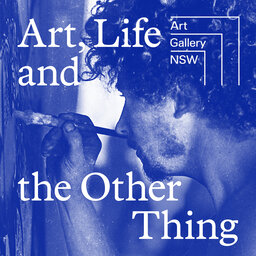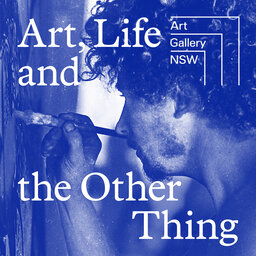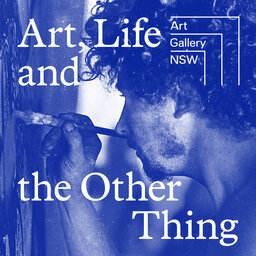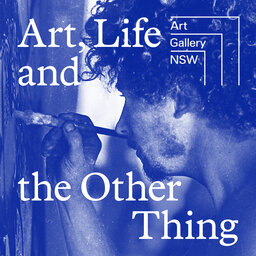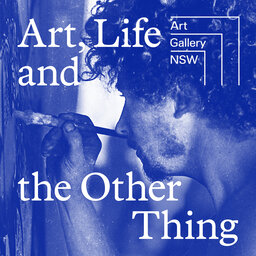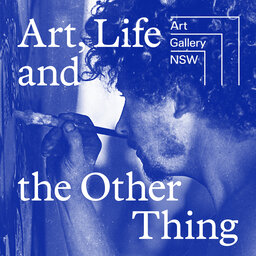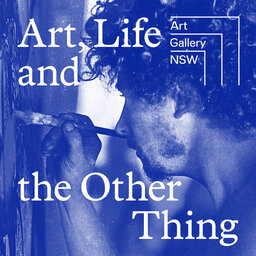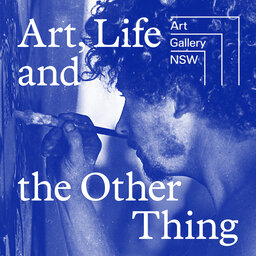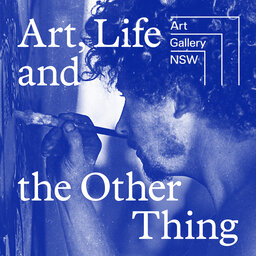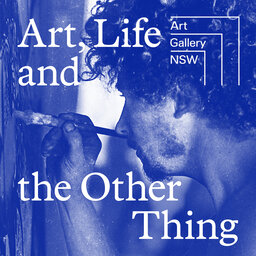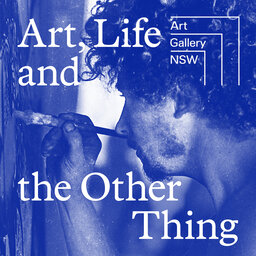Art, life and the other thing
'Art, life and the other thing' is the controversial self-portrait that won artist Brett Whiteley the Archibald Prize in 1978. In this six-part series…The artwork that lends its name to the title of this episode, and this podcast series, is the infamous and brutally honest self-portrait that won Brett Whiteley the Archibald Prize in 1978. Fenella Kernebone discusses the work with curator Anne Ryan; Wendy Whiteley; artists Mitch Cairns, David Griggs and Natasha Walsh.
To view this artwork, go to agnsw.art/bwspodcast
Podcast artwork - Brett Whiteley in his studios 1970 (detail), photo: Robert Walker, National Art Archive, AGNSW © Estate of Robert Walker.
A quick heads-up: in this series we talk about drug use, mental health issues, and there's a bit of swearing.
Welcome to the Brett Whiteley Studio. Have you been here before at all?
I'm Fenella Kernebone and this is 'Art, life and the other thing'. I'd like to acknowledge the traditional custodians of the land on which this podcast was made, the Gadigal people of the Eora Nation. This podcast is about Brett Whitely and the big questions his work brings up and his influence on Australia's arts landscape. In each episode, I sit down with some of Australia's most exciting contemporary artists and curators at the Brett Whiteley Studio to talk about his work and how it's impacted on their own careers. In this episode, we're taking a look at 'Art, life and the other thing' ... a self-portrait that won Brett the Archibald in 1978. And hey, now you know how he came up with the name of this podcast. The Archibald is Australia's most prestigious portrait prize, and although it's turning 100 years old in 2021, Anne Ryan, curator of Australian art at the Art Gallery of New South Wales, says it's just as relevant today.
It's a prize that has – a bit like Brett Whiteley – moved beyond the art world. It's something that's very recognisable for Australians. It's a prize that gets the most media attention at the Gallery every year. It gets the broadest audience every year. There's something about the prize that Australians like. I think we like to look at ourselves, and we like to think about who's interesting. And it's also a prize which can make or break an artist in Australia. Because if you win the Archibald Prize, your name becomes familiar to many people who would not have the ability to name another artist. Suddenly you're thrust ahead. It's a bit like winning Miss World. You have the tiara and the sash for the whole year, and Brett Whiteley won the prize twice, and that was a really big deal.
A big feature of the Archibald every year is self-portraits . Artists like to joke that this is because portraying yourself is cheaper than paying somebody else to sit for you – it's practical for sure – but there is a lot more to it. Self-portraiture is a genre that many artists take on. It was certainly a massive part of Brett’s career. And the way he did it took self-representation to a whole new depth. The artwork 'Art, life and the other thing': he won the Archibald with this work – a triptych in fact – in 1978. Can you describe what was and is actually quite unique about this self-portrait that he did?
So a triptych is a three-part artwork, and the triptych in this case is three different-shaped images, one of which is a photograph of Brett Whiteley looking a bit quizzical, a bit silly. It's got a sense of humour about it. The middle part of the triptych is a painting, a self-portrait of the artist holding – it's quite postmodern, it's very self referential – he's holding an image of a painting of an Archibald Prize-winner from the 1940s by an artist called William Dobell, who was quite possibly as famous in his day as Brett was when he painted this self portrait. And the third part of the work is a screaming baboon. It's a, it's a monkey with its mouth agape. It's got tears streaming out of its face. It's got pins in the hand, almost Christ-like if you picture a crucifixion, the nails through the hands of the Christ figure, which is, in a way a self-portrait. It's about his, uh, struggles with substance abuse and heroin, and it's kind of like a a primal scream, if you like.
Brett's entry was hugely controversial at the time. It divided critics, with some claiming it wasn't a proper portrait. If you'd like to see the picture online, go to agnsw.art/bwspodcast.
So visually, it's unconventional for a traditional portrait in subject matter. It would have been challenging at that period because it's talking about an issue that is controversial, you know. And it's also an interesting insight into the value that Brett Whiteley placed on his forebears. It was a caricature, and so it's become one of these pictures that's been a kind of a beacon in the history of art in Australia, about the struggle between modernism and modern art and tradition.
'Art, life and the other thing' ultimately broke through, inspiring the next generation of artists to take self portraiture even further. We'll meet a few of those artists in just a bit. But for now I want to stay on Brett. Why was he so obsessed with painting himself?
You find images of Brett Whiteley a lot in his work, and sometimes it's a portrait of his face in that conventional manner. And sometimes you'll just see his hand intruding at the bottom of a canvas or a sheet of paper holding a brush or a pencil. So he's inserting himself into a picture. All of that is self reflective and looking back at the self. I think, for Brett Whiteley, a lot of his work really was about trying to work out where he fitted in. He was very fascinated by the idea of genius and celebrity, and he was sort of a bit attracted to that. And so he was constantly kind of scratching away at that. What was creativity and where did it come from? And what is it that makes me tick? Why do I do what I do? Why am I who I am? And I think self portraiture is an expression of that concern and interest and curiosity in his own mind that gave him an out a way of trying to chip away at that.
So where did all this leave Brett? What did it reveal about the man? The person who probably has the deepest insight into this is his former wife, Wendy Whiteley.
This work is definitely a confessional. It did divide the critics. Some of the critics that normally dislike, this even made them dislike him even more. It took a lot out of Brett. It was also an attempt for himself to deal with his own addictions. He's got [a] cigarette and a syringe in this thing, so he was fully aware of what was going on with himself. The howling baboon is something we've actually seen in Ethiopia, and it's a reference, of course, to the 'monkey on my back' of heroin addiction.
For Brett, self-portraiture was a way of trying to figure out the darkest parts of himself. It also provided a safe place to play and experiment with new techniques. To this day, emerging artists are drawn to the form for similar reasons, like Natasha Walsh.
I'm Natasha Walsh. I won the Brett Whiteley Scholarship in 2018.
She's also a three time finalist in the Archibald Prize and the winner of the Kilgour Prize – another big portraiture competition in Australia. Being so accomplished, I wanted to get Natasha's read on Brett's work.
Conceptually, we can, you can engage with it. Like, it reminds me of that work with the three chairs where it's like, this is a chair, this is a chair, and this is a chair. One's the definition of a chair, one's a photograph of a chair and one's an actual chair. And this one is almost like a self-portrait in three, where one is a representation of the artists. I mean, maybe it's, you know, this lion creature. It reminds me, weirdly enough, of [Francis] Bacon, but that's probably because I went to a Bacon exhibition when I was in Paris.
Francis Bacon, the English figurative painter. Like Brett, his portraits are famous for their raw, unsettling nature. The two men also knew each other, and Brett idolised his work.
I mean, for me when you look at a Bacon [work] it's like the tragedy of the human condition and the pain of that. Is it weird that it reminds me of like a creative rage almost? And then this one in the middle there's a little drawing that the artist is obviously holding of [William] Dobell. It looks like he's actually in the process of drawing it, but it's obviously Brett Whiteley, and it's reminding me a lot of [Pablo] Picasso with the breaking up of his form. And you just see this eye that glares out at you. But I love how there's just this eye that stares out at the viewer, looking back at you because he is self aware of this whole construct of this game that he's invited you to, to play with him. And then the end with the panel on the right, with the photograph where he really I mean, he looks very, very playful in that in that sort of, yeah, very cheap, very cheeky, kind of whimsical. And it's like that's a photograph. When you make an image, you realise how problematic that is because of how much distortion is created by that lens. If I were to represent you, the definition of you, the photograph of you and the actual you, there's also the you that's inside yourself that I have no access to, or I do, I use clues and stuff. I mean, the chair doesn't say 'I'm not a chair' or 'I am a chair', but with a self-portrait , the subject has its own internal world, its own awareness.
Natasha paints incredibly detailed, translucent self portraits, sometimes on canvas or on other materials like marble. She also etches her image into copper or wax and builds boxes with mirrors to play on the idea of self reflection and the perception of self.
And I had collected this tiny little convex mirror that I think you usually attach to a window in a car like a side to give you a better range of vision.
Natasha is referring to her self-portrait that won the Kilgour Prize in 2018, called 'Within the studio (self-portrait)'.
It was about the size of a smaller than a tennis ball, slightly larger than a ping pong ball, and I thought, well, it's kind of interesting how it warps the space around me, each type of mirror, all the floors in it, and the faults and it affect the image – because I work from life – so everything is mediated. When you see yourself, it's always mediated. You can never actually see yourself. It's a mirror or a photograph. It's always... The things through which you see yourself is, it's got its own personality, its own voice. And so I've been collecting all these weird, reflective things just as an exercise. I thought I'll paint the mirror. So I painted it on the marble and I thought it was an interesting work in the sense that it actually was a self-portrait, because the copper work, I don't see it really as, you know, they're performances, whereas this work was really a self-portrait of the time in that little space where this tiny tiny corner warped around me and warped my perception and obviously affected mental health. Because how can it not when you're working in such a small space with such a difficult subject? Because, honestly, self portraits are working with yourself as a medium to explore other themes. It's really difficult because you can't escape yourself ever. You're always, that's always an aspect of the work and being vulnerable in that way.
With artists like Natasha, the creation of a self-portrait definitely has a performance element to it. It's a representation of the self, for sure, but it's never static.
You're constantly shifting, and so every time you engage with the mirror, your internal perception, which has already changed because you're always reforming who you are in terms of your brain and what you see first and what you, your insecurities, et cetera. And also physically, you are always changing. But with the copper work, it was more also an exploration of ... They're like little performances in the sense that it's not about Natasha, the artist, like that person. It's not about me, that work is about. I might be feeling this way or reflecting on something, and then I create a narrative or performance that will represent that as a way of talking about how we all experience it. Do you understand? So it's not about me as a human being. It's about looking at my own experience in an act of empathy, to engage with a more universal human experience on different ideas and issues. And like in each painting, it revolves around one of those themes which I was at that time interested in. So that's what I mean when I say 'performance', because it's that active, imaginative empathy through my own experience. But it's not about me. That's the interesting thing about portraiture. Everything that an artist does is ultimately I mean, it's said a lot, it's ultimately a self portrait. It's ultimately self reflective, and so it's kind of interesting because with a self portrait, it's honest about that. It's honest about everything that I do, everyone that I paint, and it's ultimately going to be my own perception of them, my own interests, my own sensibility.
Another Sydney artist who's been an Archibald finalist – i ncluding a few self-portraits - is David Griggs. Although David's self-portraits are very different in style to Brett's, they are often steeped in darkness and grapple with similar themes, struggles with mental health and how this impacts an artist's identity. Given this, I wanted to ask David what he thinks of Brett's self-portrait 'Art, life and the other thing'. This is the portrait that won the Archibald, the baboon, sort of the triplicate nature of it as well. So what do you see when you look at that picture, David?
I mean, I think what always blows me away with his work is say the perspective of like a thumb coming to the foreground in front of a face or say the baboon's mouth or it's like you're in that depth, he's pushed the contour of everything and he's tweaked it all and bent everything. And but at the same time, the perspective of things are completely in the right place. So for him to say abstracted or go sort of mental with it, he can't do that without that skill, that knowledge. I mean, you can see that he's so confident. I mean, even when things are out of proportion, it's out of proportionally intentional. So he obviously was pushing, you know, he was obviously trying to create – I don't think controversy is the right word –he was definitely just pushing the way to communicate through painting, which, is what we all do. And maybe he just had that little extra oomph of trying to be successful, but at the same time, sort of sticking it to the man you know, sort of thing. It's fun. It's funny, though, because when I think about, you know, because I'm also trying to push painting and push and push, and every time I think about the Archibald, I try to think about something, you know, breaking up the panels or doing something that's this or that and you know, but in a way, like Brett already did that with that piece.
There's a few comparisons that can be drawn between Brett and David's work, but one that really stands out is how much their mental state, their inner turmoil, is so centred in their self-portraits .
I started getting quite severe bouts of depression, but when it's new to you and you don't understand it, I mean it is like completely encompassing you know, you cannot function. You know, so I was very lucky that it happened to me in, say, my hometown, because I could get good help and then you come through this window and then, weirdly, over a very slow time and a lot of hard work. You almost get your life back, and then you're like, 'wow, I want to paint about this, but I don't want it to be sound morbid, because in a way you do grow and you do learn a lot about yourself, but to do that, you have to pretty much go through hell. And I think with that painting I was like, 'oh, let's just spell it out in the title'.
Talking about mental health in the art world and beyond has historically been stigmatised. But David has smashed that stigma more than anyone. Let's take his Archibald entry in 2009, 'Zoloft nation', which is all about the prescription drugs he relies on to help him with depression. In the painting, David has painted himself wearing a red-and-white-striped shirt with a smiley face emoji holding a severed hand while skulls, zombies and skeletons dance in the background, painted in bold, bright colours.
And it's sort of just my way of saying, 'this is an epidemic and this is what I've been through'. And the Archibald for me was a perfect sort of platform to have a dialogue about this. But at the same time, it was completely scary and confronting for me to, in a way, tell the whole of the Australian art world, plus a lot of public that ... Oh, you can look at this painting and you can think about mental health and you can think about this artist’s experience, and this and that. But what was really humbling from that experience was the painting became therapy. So you know this whole notion art's therapy , but then, when you're an artist, how do you say you need art therapy? How do you, you know, it's like you're doing it. And I would get all these messages from, you know, the mother of a son that committed suicide or the girlfriend of ... you know, it was like all these things going on where people would say, 'Hey, you know, like I saw your painting'. And then also, people start to just yeah, like, tell their stories. And it wasn't about the painting as a painting. It was about what the painting sort of represented, and that was sort of beautiful. And then I realised that's also the, I could not have had that type of reaction without, say, the Archibald as a catalyst for that.
So I mean, you've been in the Archibald, what is it, eight times? So why portraiture for you?
Oh, because the prize money's really good. No, to be honest, I mean, look, it's lols because, let's be honest, it's going to save a lot of artists' asses if they can win that, it's going to change things drastically. Even if it's for a year or two years, it can really change your way of life. For me, there's a few reasons why I always enter, you know, my grandmother was a painter, and I sort of promised to her [in her] last few days on the Earth that when I win, and I would mention her in the speech 'cause she got so excited when I started getting hung. And this might sound corny, but I do have a weird obligation to Australian art slash Australian culture. Because I think with the Archibald, it's interesting that it's been renowned that you paint celebrities or, you know, and I always found that that the artists almost became secondary to the subject. I don't know what Brett was thinking, but for me it was like I started doing self portraits and it wasn't, and it wasn't a narcissistic thing. It was like, 'let's bring some power back to the artists for once.' And I don't always paint self portraits because there are other people that I admire and want to paint. I just felt like I don't really care about that TV presenter , you know?
So where are you now? Are you in a good place?
Yeah, I mean, I'm in a really good place. Everything is good. I mean, I guess I'm just one of those people that always likes a good challenge. Thinking about the future, you're thinking about... It's always a good place.
Another artist who has been somewhat influenced by Brett Whiteley is Mitch Cairns.
I make paintings, mostly.
He won the Brett Whiteley Travelling Art Scholarship in 2012 and, like Brett, he's an Archibald winner. But it was a portrait of his partner rather than a self portrait that scored him the top prize. So we'll talk to Mitch more about that work in episode five, but it's self-portraiture that I want to talk to him about now. And we're sitting down, we're in the upstairs section of Brett Whiteley Studio. Have you been here before?
Many times as a high school student. Those large totemic sculptures of Brett's were definitely present, and they were quite wild, sort of a wild thing to see that didn't really, there wasn't much out there like that at that age for me.
We're sitting up here and one of the reasons we're sitting here is because over on your right is this painting, which ended up picking up the Archibald Prize in 1978. Can you tell me your thoughts about this painting?
It's actually really unusual looking at it, because, again, going back to what we were saying about having studied Brett as a young person, the fact that it is actually a real painting in a real room that we're sitting in now and you have all of that stored up, we've got a bit of a Rolodex of images in our brain. It pops up as I look at the painting. There is a kind of quality of like, oh, that's it. Yeah.
Mitch Cairns is a figurative painter, and his work is abstracted, which is something Brett deployed in many of his works as well. But Mitchell's paintings are full of bold block colours and angular lines. They hint at the modernist painters like [Henri] Matisse or advertising prints from the 1920s. So what is it that inspires him about Brett's work?
Whiteley was a fantastic draughtsman, and the thing that I'm most attracted to is his, the articulation of line in his work. And I, as someone who draws, is pretty much focused on that aspect of drawing, it's not really about pulling out a form or or defining something other than ... I'm not looking for another dimension, really. Looking over your shoulder at a couple of drawings here and like there's a framed drawing of his sculptures, which is very much a suite of working drawings full of sculptures. And there's another one, which is a sort of an interior sleeping figure, which is far more finished. And obviously he got lost in the act of drawing and really indulged. I'm not sure if I indulge that much in it. I really just need it to sort of keep things rolling.
You've said that portraits are really tough, like that they can cause burnout. What is it that for you, you find such a challenge when it comes to painting a portrait?
Because I'm a very intuitive picture maker and my subjects move around a lot. Each portrait that I've painted - and I can probably count on one hand the amount of portraits I've made – they're are real investment in time and energy. And there's a lot of lot of drawing involved in them. It's not just a painting of someone. It's very much about wanting to make sure that you're able to honour them in the right way. And there's very much a sense of wanting to please them, rightly or wrongly. You want to make sure that they felt safe throughout the process and you're not misrepresenting them. The duty of care aspect is probably the heaviest burden, if that's the right word.
Of course, there are burdens that come with painting yourself as well, and we can see that when we're looking at Brett Whiteley's work. So why paint yourself? That urge for artists to scratch the surface and stare inwards, to try to understand what really is there. That seems to be a driving force for so many artists to delve into self portraiture. I suppose many of us have our own ways of doing things, some write and make music. Some artists draw themselves, and by doing so, artists like Brett allow us a rare peek inside their minds, their inner turmoil, things that they might struggle to say in words. Maybe that's why so many of us are drawn to portraits. Thank you to this episode's guests: Anne Ryan, Mitch Cairns, Wendy Whiteley, David Griggs and Natasha Walsh. This podcast has been brought to you by the Brett Whiteley Studio in collaboration with the Art Gallery of New South Wales. You can visit Brett Whiteley's studio in Sydney from Thursday to Sunday, and admission is free. I'm Fenella Kernebone, thanks for joining me.
 Art, life and the other thing
Art, life and the other thing